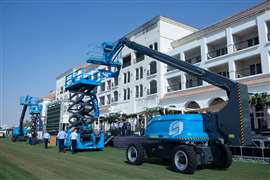Developments in the energy sector
19 August 2013

Around the world power and energy related projects continue to be rapidly developed. Work on these varies, from expansion work and carrying out maintenance, to lifting vessels, for example, and placing hydro cracking reactors. For these larger and heavier jobs, crawler cranes are the most in demand.
“A typical crane for this type of work is the 1,600 tonne capacity CC 8800-1 crawler,” says Rüdiger Zollondz, Terex Cranes product marketing director. “There is also the Twin version of the CC 8800-1, which has a kit that adds another boom.”
An example of a CC 8800-1 working on an energy project is at the Canadian Natural Resources Ltd (CNRL) project in Fort McKay, Alberta, Canada. It is being used to construct a unit, made of 600 tonne modules, that will process oil sands (large reserves of oil embedded in sand) into bitumen. Contractors for the site are Sarens and Tecnicas Reunidas (TR), based in Spain. The first lift is scheduled for February 2014.
Another heavy lifter in demand is the Lampson Transi-Lift LTL-2600, which is being used at the Sanmen Site for the China Nuclear Energy Industry Corporation in Zhejiang Province, China. Project and lifting work for the crane includes helping with the construction of a nuclear power station. Work at the plant has already begun and is due for completion in 2014.
Although crawlers are the most common choice of crane type for work at energy projects, rough terrains are also widely used. Due to their ability to navigate through tight spaces and comfortably work in confined areas, rough terrains are typically used for carrying out maintenance works. For other types of energy projects, such as electricity transmission work, which includes the installation of electrical power supplies, boom trucks tend to be the favoured solution. This is especially true throughout the USA.
Jim Glazer, Elliott Equipment Company president says, “We have seen a big demand for our longer boom Elliott cranes with tip heights from 56 to 64 m and capacities of 36 tons [32 tonnes] and above. These have primarily been used in utility transmission construction applications throughout North America. We have also seen strong demand for our 45 ton [40 tonne] and 18 ton [16 tonne] cranes in oilfield service applications, primarily in Texas and California.”
Demand for 40 tonne capacity truck cranes are also strong in other parts of the world. An SQ16ZK4Q truck mounted crane manufactured by XCMG, for example, has been working at a thermal power project in Cambodia. The site is the largest complex of sugarcane, ethanol and thermal power plants in Cambodia. The truck crane, from XCMG’s SQ series, has a maximum load moment of 40 tonne-metres and a lifting capacity of 16 tonnes.
Projects
As the number of energy projects undergoing construction continues to grow, the demand for lift service providers also increases. Kate Lampson has seen a growing demand for lifting services throughout the energy project industry, “We are in demand for projects including power plant construction, refinery work, wind tower erection, nuclear power plant construction, bridge work, solar panel installations and the construction of liquid natural gas plants.”
The increasing work has also had an effect on rental companies. Mumbai, India-based rental company, The Bhoir Group, for example, has taken delivery of its fourth Liebherr LR 1300 crawler crane in less than 18 months. Two of the 300 tonne capacity lattice cranes are working on the Koradi Thermal Power Station expansion project close to Nagpur in Maharashtra, India, which is one of four major power stations in the region. Its capacity is 1,080 MW from seven coal-fired boilers that were installed more than 25 years ago.
For the project the two LR 1300s will help install three new 660 MW thermal boilers, doubling the generating capacity. Installation of the boilers started in May 2011 and completion is by the end of 2014; the first boiler will be commissioned at the end of 2013. Larsen & Toubro Power, the main contractor for the project, rented the two Liebherr LR 1300s for the lifting operations. The crawler has a main boom of up to 98 m and a maximum 113 m luffing jib allowing a maximum height of 172 m (59 m main boom + 113 m luffing jib).
Flexibility is an important feature for companies renting out cranes and equipment for use in the energy sector, as Jim Glazer points out, “Most of the machines servicing the transmission market are rented with work platforms and remote controls. We have received a great deal of positive feedback about our radio remotes with built-in LMI displays, friction free jib extension to allow for easy deployment and also our multimode glide swing system. We also offer track vehicle mounting, and add digging systems to many machines, further increasing their flexibility.”
Flexibility on boom length is another customer demand, Zollondz adds, “Customers working in the petrochemical sector like cranes with long booms; however, they still want the option of having a short boom. To meet this demand we introduced the 75 tonne capacity Quadstar 1075L rough terrain crane. The RT has a 41.8 m telescoping boom and a 45 m main boom maximum tip height. The boom design accommodates an 8 m, 20 degree off-set jib.”
Although flexibility is a common demand from customers, in some situations, different energy projects call for different crane models altogether. As Kate Lampson explains, “The crane model we use depends on the type of energy project we are working on and the scope of the project. For most projects we are seeing a demand for the Manitowoc 4100, Manitowoc 4600 with and without the ring attachment, Manitowoc 18000, Manitowoc 2250 with and without Max-Er attachment and the Lampson Transi-Lift LTL-1100 and LTL-2600 models.”
In addition to flexibility, being easily transportable is another requirement. “In transmission work, it is important that the equipment doesn’t require permits for highway use,” says Glazer, “This is because cranes are moved from point to point frequently.” To overcome potential road regulation problems, Elliot Equipment has specially engineered several units to allow for permit-free application.
Mega tower systems
In the near future, petrochemical vessels are expected to weigh more than 4,000 tonnes. A trend is already developing in China. To meet the demand, manufacturer of heavy lift and hydraulic jacking systems Dorman Long Technology (DLT) has designed a modular jacking tower system that is capable of handling vessels that weigh up to 5,000 tonnes. The MYQ5000 was designed by DLT for China Petroleum First Construction Company (CPFCC) based in Henan province, China.
The tower system will be used for the erection of petrochemical vessels weighing up to 5,000 tonnes and up to 160 m high, the company said. The system allows vessels to be moved longitudinally, transversely and rotated after lifting using a 5,000 tonne capacity swivel incorporated into the modular lifting beam.
The MYQ5000 has a free standing height of 90 m, a lifting speed of 23 m per hour using four DL-S1394 strand jacks (1,394 tonnes capacity per jack), and longitudinal and transverse movement speeds of 25 m per hour using four DL-CP400 pinned skidding jacks (400 tonnes capacity per jack). The system only occupies a small foot print on site and is easily transportable. It will be manufactured by Dorman Long Technology in its Shanghai works for delivery in early 2014. The system is intended initially for work inside China, but has been designed by DLT for use internationally.
Enerpac also has a free-standing gantry system, the Enerpac Self-Erecting Tower (ESET), for erecting reactor vessels in petrochemical plants. It can lift loads up to 1,400 tonnes to a height up to 75 m using heavy lifting strand jacks with gantry and skidding equipment. The gantry system is easily transportable and is suitable for use at refineries, nuclear power plants and in the petrochemical industry. It is being used in Russia to position large vessels in oil refineries.






